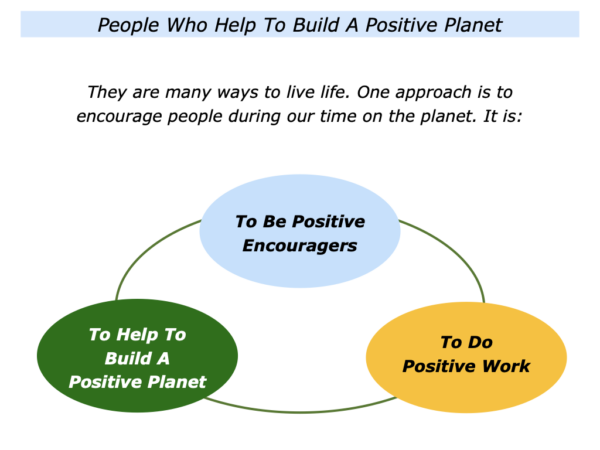
There are many ways to live life. Some people aim to encourage others in their lives and work. They also aim to do positive work and help to build a positive planet.
Different people follow this approach in different ways. Let’s explore how some people aim to planet seeds of hope during their time on the planet.
They Aim To Be
Positive Encouragers
Different people encourage others in different ways. Some do it by being kind. Some do it by acting as positive models. Some do it by helping others as parents, friends, educators, mentors, leaders or in other roles.
Some do it by providing practical tools that people can use to shape their futures. Some do it by helping people to increase the quality of their lives. Some do it by helping people to achieve their picture of success.
Looking back on your own life, can you think of a person who has encouraged you? This may have been a parent, teacher, coach, manager or another person. What did they do to encourage you?
If you wish, try tackling the exercise on this theme. This invites you to complete the following sentences.
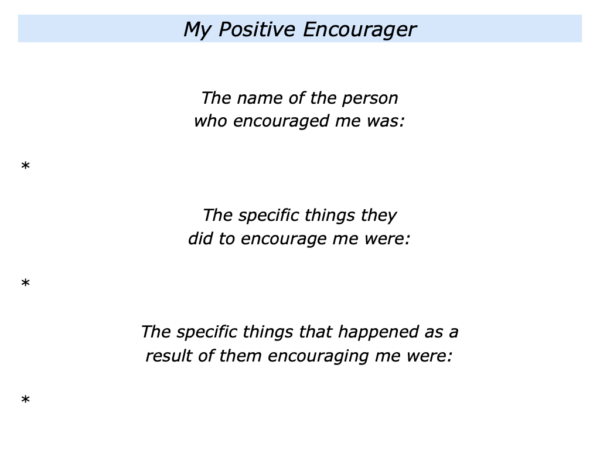
Some encouragers create a stimulating sanctuary in which people can feel at ease and able to talk about their goals. When appropriate, they then encourage, educate and enable people to achieve their goals. Such people take the following approach.
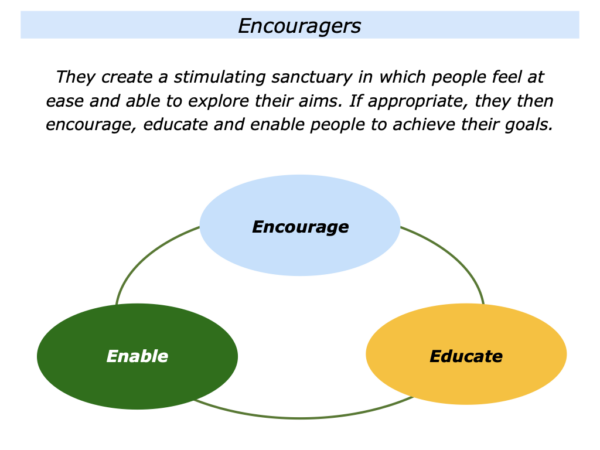
They Aim To
Do Positive Work
Some people aim to do positive work that helps people or the planet. Some aim to serve something greater than themselves. Some develop a purpose, follow their principles and achieve a certain picture of success.
Some aim to build on their strengths, do satisfying work and help others to achieve success. Some aim to create positive teams or organisations. Some aim to pass on knowledge that people can use to shape a positive future.
Different people follow this approach in different ways. The following section looks at people who have applied their strengths to do positive work during their time on the planet.
Mary Gordon – The Roots Of Empathy
Mary Gordon chose to help people to build positive relationships. She founded the organisation and programme called Roots of Empathy.
This aims to build caring, peaceful and civil societies through the development of empathy in children and adults. Here are excerpts from the organisation’s website.
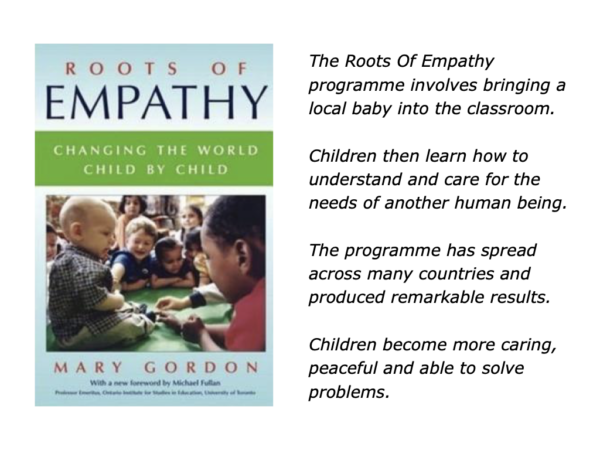
In the programme a parent and baby (who is two to four months old at the start of the program) from the community visit a classroom nine times over the course of a school year.
A trained Roots of Empathy instructor visits with the family to guide children as they observe the relationship between the baby and its parent.
The instructor also visits before and after each family visit to reinforce teachings. There are 27 classroom visits in total in a Roots of Empathy program.
In the program, the baby is the “Teacher.” With each family visit, the instructor leads the children in noticing how the baby is growing and changing over the course of his or her first year of life.
The children also watch the loving relationship between the parent and baby and see how the parent responds to the baby’s emotions and meets the baby’s needs. The attachment relationship between a baby and a parent is an ideal model of empathy.
Children learn to understand the perspective of the baby and label the baby’s feelings. They are then guided in extending this learning outwards so they have a better understanding of their own feelings and the feelings of others.
Mary chose this path to pursue a compelling purpose. This has helped many young people to develop skills they can use to build positive relationships in their future lives.
Paul Hawken – Growing A Business
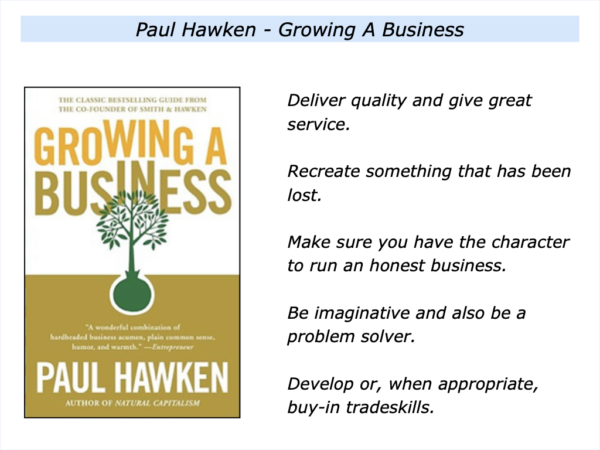
Paul Hawken has a long history of helping people to build on their strengths and make their best contributions to the planet. He began by working as a press coordinator with Martin Luther King’s team in Selma, Alabama.
Whilst continuing to work for human rights, he moved on to creating several ethical companies. Paul founded Erewhon, which was based in Boston, Massachusetts. This focused exclusively on organically produced fruits, vegetables, dairy, beans, eggs, juices, and condiments.
By 1973, Erewhon had two mills, two rail cars and warehouses on both coasts. It had contracts with farmers in 37 states on 56,000 acres to supply its four stores and more than 3,000 wholesale accounts.
Paul then created Smith & Hawken – a $75 million catalogue and retail company, specialising in garden and horticultural products. It is credited with changing gardening in America by introducing European tools, techniques, varieties and literature.
His work as a practitioner – rather than just a theorist – led to him producing many books. These included The Next Economy, Growing a Business, The Ecology of Commerce and Blessed Unrest.
Paul reached millions of budding entrepreneurs through his 1980s American Public Television series Growing A Business. He advised people to develop their talents and produce quality. Many of the tips sound commonplace today, but back then they seemed radical.
Deliver quality and give great service
Deliver quality and make people feel special. Even in a recession, customers will pay for quality products delivered in a quality way. Paul explained that it is vital to focus on helping your customers.
You are trying to give your customer something other than what they are receiving from the competition. Remember that in business you are never trying to ‘beat’ the competition. It is a waste of time and energy trying to beat the competition because the customer doesn’t care about that rivalry.
People are attracted to nostalgia – so recreate something which they believe has been lost forever. The friendly small town bank; the reliable mail-order firm or the honest garage. The quality ice-cream shop; the traditional cheese store; the aromatic coffee shop; the company that fixes mistakes without complaint.
Be imaginative – because too
much money is worse than too little
Businesses suffer from a lack of imagination not capital, says Paul. Too much money tends to replace creativity. Companies without money are hungry; they must dream, imagine and improvise.
Companies awash with money try to buy solutions. They lavish vast amounts on consultants, lawyers, clever accountants, publicity agents and marketing studies. Cash and creativity are both necessary, but make sure you balance them properly.
Entrepreneurs are risk-avoiders
The common wisdom holds that entrepreneurs love to take risks, says Paul, but that’s mostly hype. He explains:
Once the entrepreneur has seen how to create a product or service to meet demand, much of what the outsider perceives as risk in the situation is erased.
Entrepreneurs are like mountain climbers. They set clear goals, clarify their strategy and anticipate ways to tackle problems. On-lookers think the mountaineer is gambling, but the climber would risk more by not following their dream.
Business tests character
Business teaches you a lot about yourself, says Paul. You will face split-second decisions, to be honest or lie; to deliver quality or cut corners; to care for your customers or give shoddy service. He explains this in the following way.
The moment you enter the world of business – as a provider – not merely as a consumer – you will have a hundred opportunities a day to act beneficially or wrongly, to deal with people fairly or otherwise, to enhance your social environment or pollute it.
Businesses will always have problems
Paul once searched for magic solutions. Providing he read more books by business gurus, one day he might find business nirvana. Such enlightenment would make all his problems disappear. But then another truth hit him one sunny autumn afternoon. He wrote:
I had my nirvana, all right, but it was the opposite of what I had been seeking. On that pretty afternoon the actual truth finally struck me: I would always have problems.
In fact, problems signify that the business is in a rapid learning phase. The revelation was liberating. I couldn’t understand why other people hadn’t told me this earlier.
Problems create either energy or paralysis, says Paul. Get used to problems, they are an eternal part of everyday business. They may also present a chance to improve. You can then keep developing a positive business.
Different people do different kinds of positive work. Some also take the following step.
They Aim To Help To
Build A Positive Planet
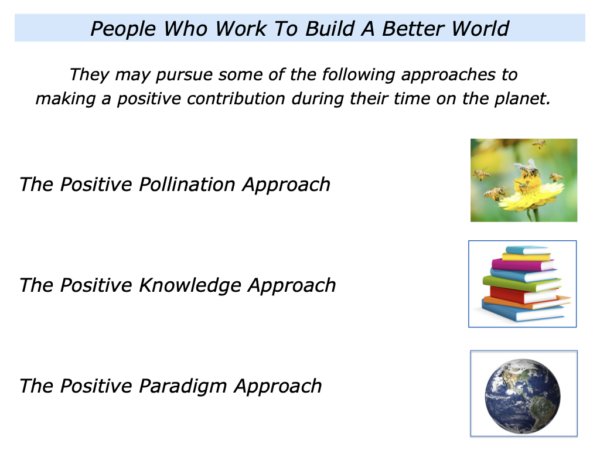
Different people choose different ways to make a positive contribution during their time on the planet. There are many views about how to help to build a better world. Here are some of these approaches.
The Positive Pollination Approach
People who take this approach aim to plant seeds of hope and encourage other people. They share positive models and practical tools that people can use to get positive results. They believe these seeds may spread and, through the pollination process, help to build a positive planet.
The pluses of this approach are that it is organic and it provides positive models that work. People are then more likely to share these and help to build a positive planet. The minuses are that it takes a long time.
The Positive Knowledge Approach
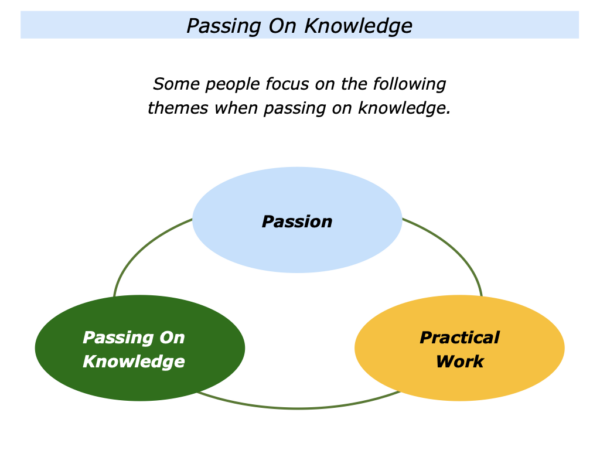
People who follow this approach often focus on something they feel passionately about. They may then aim to pass on positive knowledge that other people can use to shape their futures. Such people may have specialist expertise, but they are also savvy.
They aim to do practical work and pass on positive models that will create wins for all the various stakeholders. They aim to show how taking these approaches will be profitable for both people and the planet.
The pluses of this approach are that it provides knowledge and practical tools that people can use to achieve success. The minuses include that there it is up to the receiver how they interpret and use the information.
The Positive Paradigm Approach
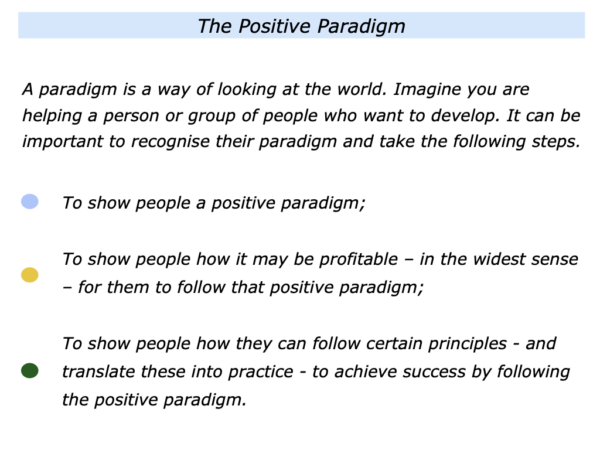
A paradigm is a way of looking at the world. The paradigm that we have often influences our daily actions.
Imagine that you are working with a person or a group of people who may want to develop. It can be important to recognise their present paradigm and then to take the following steps.
To show them a positive paradigm;
To show how it may be profitable – in the widest sense – for them to follow that positive paradigm;
To show how they can follow certain principles – and translate these into practice – to achieve success by following the positive paradigm.
If appropriate, you can then encourage and enable people to follow this approach successfully. This may mean that people are happier, healthier, wealthier or leave a positive legacy.
The pluses of the paradigm approach are that it can show a way of living that produces benefits for people. The minuses are that it can come across as criticism or preaching. It can also be difficult to encourage people to shift their belief systems.
Different people follow these approaches in different ways to make a positive contribution. The following section looks at some people who aim to help to build a positive planet.
Ellen MacArthur – The Circular Economy
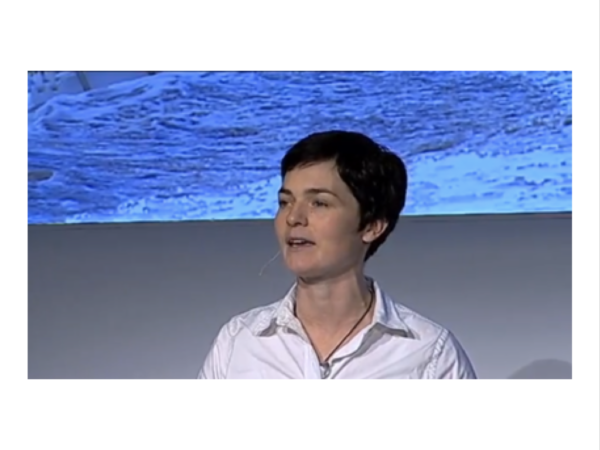
Ellen became famous as a yachtswoman at the age of 28 when she made the fastest ever single-handed circumnavigation around the globe. The journey was thrilling, frightening and illuminating. It also planted the seed of what she could do for the planet.
Ellen later described how being on the yacht called for living on finite resources. She then extrapolated this approach to living on the Earth. Thriving on the planet called for developing a circular economy.
There are fundamental differences between a circular economy and a linear economy. Ellen explained these in an interview she gave to Marcus Fairs for the design website called dezeen.
The linear economy is a straight line, no matter how efficient you make it. If you make a car with less material, if you make a car using less energy, you’re still using stuff. You’re still consuming materials.
Whereas within a circular model, from the outset you design in a way whereby that product comes back into the system.
The components are recovered, the materials are recovered, the item itself is perhaps distributed in a different way, via providing mobility, rather than selling a car.
She did a massive amount of research before setting up the Ellen MacArthur Foundation. This now works with businesses, cities and other organisations that aim to apply the principles of a circular economy.
The Foundation’s mission is: To accelerate
the transition to a circular economy.
Ellen recognises that people are more likely to make changes when they see that these will be beneficial. During her interview with Marcus Fairs she described some of the economic benefits of the circular economy.
In the early stages, we were looking at the economic value of a circular economy. The first report came out in January 2012.
We took five products: cotton, a light commercial vehicle, a washing machine, a mobile phone and a smartphone.
We didn’t know whether it would be economically viable for any of those to be circular. But in all five cases we found it was better economically to be circular than linear.
The figure was $630 billion [in savings] per year – and that was only based on recycling less than 25 per cent of the components, materials and products. So actually, there’s a huge economic value in shifting from linear to circular.
Then we did a second one on fast-moving consumer goods, which was 700 billion US dollars [of savings], and a third one looking at global supply chains, which was over a trillion US dollars. We really began to prove that circular is an economic benefit.
Sailing around the world called for courage, strategic thinking and detailed planning. It also called for resilience on the way towards delivering the goods. The Ellen MacArthur Foundation embodies these qualities as it aims to speed up the transition to a circular economy.
Roger Fisher – Helping
People To Find Solutions
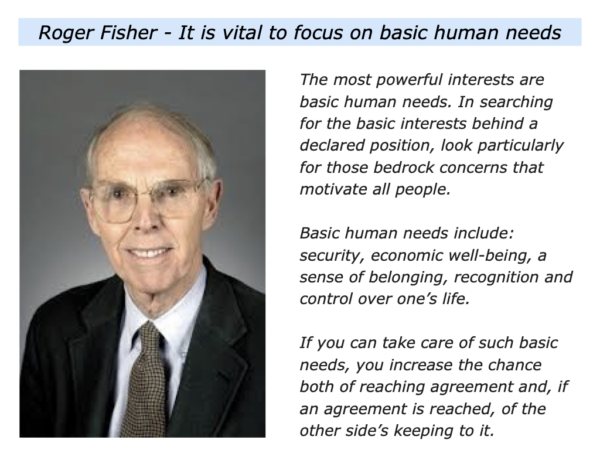
Roger Fisher made a great contribution to peace. Known for his books on negotiation such as Getting To Yes, his obituary in the Economist described him as a lawyer, teacher and peacemaker.
His approach was different from that of many lawyers. Roger focused on creating alignment, rather than seeing negotiation as an adversarial process. He believed the keys were for people:
To sit down together side-by-side;
To show respect, listen and understand each other’s needs;
To focus on the job to do – which was to find a solution;
To work together to solve the problem;
To build the foundations for ongoing peace.
Roger was invited to help people resolve differences in many parts of the world. He often began by helping people to get to know each other and build rapport.
This involved doing simple things such as eating together, listening actively and focusing on common interests. When appropriate, he would then say:
“We have a shared concern here. Let’s work together. How do you see it?”
Roger served in the Second World War as a weather reconnaissance officer. But he was strongly affected by the loss of his roommate and many friends.
During his service he also flew morning flights over Japan. This was before the bombing of Hiroshima and Nagasaki. According to people who knew him, the memory of these flights – and the unnecessary deaths of many people in war – weighed on him.
Although building a great reputation in Academia, he threw himself into applying the ideas in practise. This involved him working in Europe on the Marshall Plan.
Later he contributed to seeking peace in the Middle East. This involved working on President Sadat’s trip to Jerusalem and the subsequent summit at Camp David.
Roger played a significant part in helping to release the United States citizens taken hostage in Iran in 1981. He helped to resolve the war between Ecuador and Peru. He also spent considerable time in South Africa, helping to bring together people to end Apartheid.
His work became widely known as a result of the book he co-wrote with William Ury, Getting To Yes. Since its publication in 1981 it has sold many millions of copies. This described how people could follow five principles to find solutions.
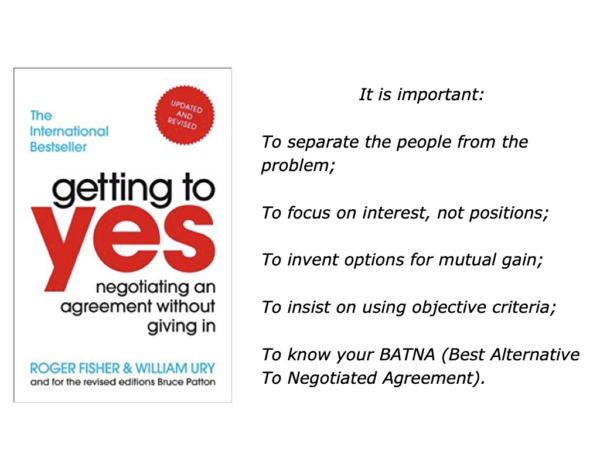
Roger believed it was important for people to build on what they had in common. He taught law students to focus on alignment. This was uncommon in law, where people often took adversarial positions.
He also believed it was vital for the parties involved to show respect to each other as human beings. Wherever possible, it was important to separate the problem from the people. Providing you looked at what each of the people wanted, it was then often possible to solve the problem.
Roger used his warmth, compassion and skill to help many people find solutions to challenges. He summarised his approach in the following way.
Any method of negotiation may be fairly judged by three criteria: It should produce a wise agreement if agreement is possible. It should be efficient. And it should improve or at least not damage the relationship between the parties.
The Ashoka Organization –
Supporting Social Entrepreneurs
Ashoka is a pioneering organisation that supports social entrepreneurs across the world. These entrepreneurs aim to improve the quality of people’s lives. They may focus on education, medical care, agriculture, housing, broadcasting or any field of human need.
Such people have the passion and practical skills to translate their vision into reality. Bill Drayton, the organisation’s founder, explained this in the following way.
What differentiates Ashoka Fellows from mere idealists is that, for these rare men and women, an idea can bring satisfaction only when it is realised.
Possessing the same unstoppable drive of a Steve Jobs, they define new issues and create new approaches. Their innovations then set new yardsticks of performance for helping society.
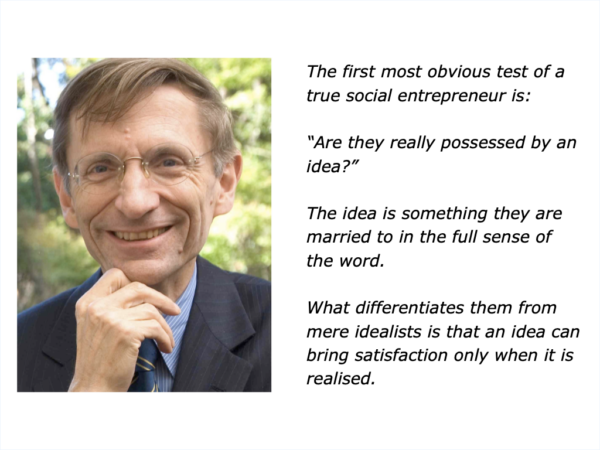
Ashoka’s Fellows have the ability to make ideas stick. Based on research, the organisation’s web site explains the results.
“By the end of their 5-year fellowship, between fifty and sixty per cent of the Fellows have changed national policy in the countries where they have been working, and ninety percent have seen independent institutions copy their innovations.”
Why the name Ashoka?
Bill Drayton started the organisation in 1980. He chose the name in recognition of Ashoka, a great leader who transformed the Indian sub-continent in the 3rd Century BC. (Sometimes his name is also spelt ‘Asoka’.)
Emperor Ashoka initially threw himself into waging war against his neighbours but became horrified by the carnage. Converting to Buddhism, he dedicated himself to improving people’s lives.
Deeply committed to his own beliefs, Ashoka nevertheless spread religious tolerance. Historians are split over the value of his legacy, but all agree that his reign produced great prosperity. H.G. Wells wrote in his book Short History of the World:
Amidst the tens of thousands of names of monarchs that crowd the columns of history the name of Ashoka shines, and shines almost alone, a star.
His reign for eight-and-twenty years was one of the brightest interludes in the troubled history of mankind.
He organised a great digging of wells in India and the planting of trees for shade. He founded hospitals and public gardens and gardens for the growing of medicinal herbs.
He created a ministry for the care of the aborigines and subject races of India. He made provision for the education of women.
“Such was Ashoka, the greatest of kings. He was far in advance of his age.”
Bill Drayton and Social Entrepreneurship
Bill was born in New York City in 1943. He came from a family of practical idealists who, amongst other causes, fought for the abolition of slavery and for women’s rights. Speaking to Good Magazine, he explained this in the following way.
“Both my parents showed extraordinary (most would say madly unrealistic!) freedom of spirit at 19. Public service and respect for ideas is a recurrent theme in both the American and Australian sides of my family.
“The fact that the Grimke sisters (anti-slavery and women’s equality) and Wendell Phillips (abolitionist) lie on different branches of the America family suggest another element of deep-seated cultural values that drew these people to one another and, without a word being said, was another wonderful gift from my family.”
Looking back at his life, Bill recalls his own first encounters with entrepreneurship. Starting a one-page newspaper when at primary school, he soon built it into a large publication supported by adverts. He explained this in the following way.
“I can’t tell you how excited I was to get this mimeograph machine. It’s amazing how supportive my parents were. There were 64 piles of mimeographed paper that had to be collated and stapled, and it never occurred to me this might be inconvenient to my family.”
Moving through schools, he became increasingly conscious of social entrepreneurs. These included people such as:
Susan Anthony – who fought for Women’s Rights.
Mahatma Gandhi – whose spiritual leadership helped to guide India to independence.
Florence Nightingale – whose work in the Crimean War helped to found modern nursing.
Bill went on to study at Harvard, Oxford and Yale Law School. It was during a summer break at Harvard that he became gripped by the power of social change.
Vinoba Bhave, a disciple of Gandhi, was walking across India, persuading individuals and whole villages to legally ‘gift’ their land to him. He then redistributed the land more equitably to support untouchables and other landless people.
Bill was 20 years old at the time and on vacation in Munich. Hearing about Bhave’s work, however, he drove a Volkswagen van from Munich to India to join him.
Returning to the USA, Bill organised Civil Rights sit-ins – an event he later described as one of the more formative experiences of his life.
Pursuing his professional career, he worked at McKinsey, the consulting firm, and as an administrator at the White House during the Carter years. One of his key legacies was the carbon emission trading scheme.
Whilst having a strong academic background himself, Bill believes it is now vital to help young people to develop other skills. These include empathy, problem solving and teamwork. Here he describes some of these qualities.
Building Ashoka
Inspired by social entrepreneurs from the past, Bill decided to found Ashoka. It started with an annual budget of $50,000. This was seeded by the MacArthur Fellowship he was awarded.
The budget has now grown to more than $30 million. The first Fellow was elected in India in 1981. Today it supports over 2000 Fellows in more than 60 countries across the world.
It is funded by individuals, foundations and business entrepreneurs. It does not accept funding from government institutions. Ashoka explains its philosophy as founded on the premise that:
The most effective way to promote positive social change is to invest in social entrepreneurs with innovative solutions that are sustainable and replicable, both nationally and globally.
Bill disagrees strongly with the notion that ‘today there is less leadership in the world.’ He believes people are retaking charge of their lives – particularly in the citizen sector. Why? Older institutions no longer serve the emerging needs.
Learning from business entrepreneurs who have dominated the past 30 years, many caring people are becoming what Bill calls changemakers. Speaking to US News and World Report, he explained this in the following way.
“(The social sector) has been generating jobs at 2.5 to three times as fast as the rest of society. The U.S. more than doubled the number of IRS-recognized charities in a decade.
“Brazil grew from somewhere between 500 and 3,600 citizen groups in 1980 to an estimated more than 1 million by the year 2000. There are similar statistics from every continent.”
Talent is flocking to the sector, says Bill, because people believe it is where they can make a positive difference.
Certainly there is a place for pressuring old institutions to change, but it can be quicker to build successful prototypes. Let’s explore one of the ways that Ashoka helps to make this happen.
Ashoka supports social entrepreneurs
Social entrepreneurs are the engines of social change and role models for the citizen sector, says Ashoka. It provides such people with a living stipend, often for three years.
This allows them to work full-time on implementing their idea. Additionally it provides them with ‘entrepreneur-to-entrepreneur’ support and access to expert advice.
Ashoka spends a considerable amount of time selecting its Fellows. It looks for five qualities in such people. Let’s explore these themes.
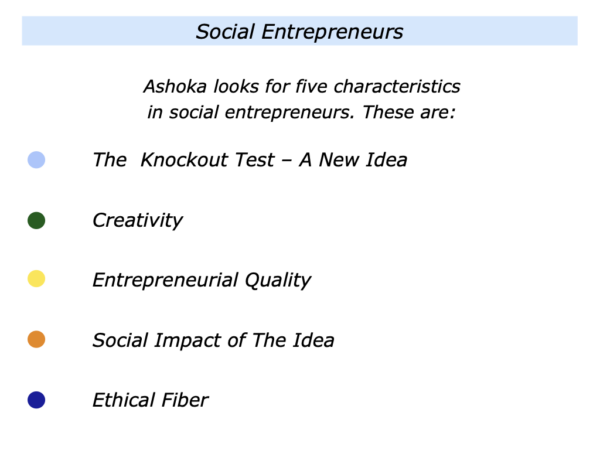
They must have a new idea
– this is The Knockout Test
The person must be possessed by a new idea. It must be a new approach to a social problem that will make a breakthrough in a particular field.
Joaquín Felipe Leguía Orezzoli, for example, is creating ‘Children’s Forests’ in Peru. The grandson of a former President of Peru, he involves children in managing the community forests. The Ashoka site explains his story.
As a child, Joaquín’s garden was a refuge from the world and a space to explore his imagination.
After his mother married a Swedish businessman who worked in the Amazon, Joaquín spent his summer vacations in the jungle, which further inspired his creativity.
There, he also became friends with a young Shipibo indigenous boy who shared adventures with him and inspired his early interest in the role of children in the environment.
After a failed attempt to please his parents by studying business, the political situation in Peru led Joaquín to finish his studies in the United States, where he earned his bachelor’s degree from Cornell University in natural sciences.
After returning to Peru and working in a variety of public, private, and non-profit jobs, Joaquín attended Yale University and earned his master’s degree in environmental management.
He travelled to Bolivia to study the role of indigenous children in community development for his thesis project, an experience that affirmed his conviction to work in youth environmental conservation.
Returning to Peru in 1995 he and a friend founded the Association for Children and the Conservation of Their Environment.
Joaquín’s idea passed The Knockout Test. The organisation he leads aims to increase children’s appreciation of nature and equip them with practical skills to sustain their environment in the future. Many of these areas go on to be actually managed by the young people.
They must have creativity
Creativity is crucial. Ashoka asks some of the following questions regarding candidates.
Does this candidate have a vision to meet some human need better than it has been met before? Do they have a history of creating other new visions?
Creativity obviously comes in different forms. Ashoka is looking for people who can move beyond their original idea and find creative solutions on the road to success.
They must have
entrepreneurial quality
Great entrepreneurs get the right balance between innovation, implementation and impact. They start by having an innovative idea, but this is only the start.
They want to implement the idea and make a positive impact. Ashoka’s entrepreneurs are possessed by their vision and want to translate it into reality. They are dreamers who do and deliver.
They must have an idea
that has social impact
Ashoka focuses on the candidate’s idea – not just the candidate. The idea must be able to live beyond the person’s involvement.
Marie Haisova, for example, has involved women in reducing pollution in major Czech cities. The Ashoka site describes some of her achievements.
Marie’s program encourages mothers to spearhead the development of a beautiful and healthy urban environment of new parks and green spaces.
Her program provides training and leadership-building seminars for women so they can effectively launch their own neighborhood campaigns.
By providing women with the opportunity to change the area in which they live, Marie is both improving the poor condition of city environments and empowering women to become active community leaders.
They must have ethical fiber
Social entrepreneurs must have an internal moral compass. This is called into action on many occasions.
First, when they face setbacks. Can they revisit their inner values and make decisions based on this compass?
Second, when they invite other people to adopt a fresh approach towards tackling a problem. Ashoka says that people will ask: “Do we trust this person absolutely?”
Third, when they experience pressure or personal attacks. The candidate must then be seen to behave ethically in every way.
Ashoka envisions a world where ‘Everyone is a Changemaker’. This is a world that responds quickly and effectively to social challenges. It is one where each individual has the freedom, confidence and societal support to address any social problem and drive change.
This is the organisation’s vision – so what is the reality? Between 50% and 60% of the Fellows change national policy in their respective countries. Ninety percent see independent institutions copy their ideas. This is a remarkable bottom-line in any language.
Bill Drayton is optimistic about the future. Outlining his view of the part Ashoka can play in history, he gave the following view to the US News and World Report.
I have never doubted that we are serving the most powerful and most hopeful historical force of our era. Or that we are positioned to play a truly important role. We are, after all, a community of most of the world’s leading social entrepreneurs.
How could any entrepreneur, confronted by such amazing opportunities to help transform the world and to do so with such extraordinary colleagues, be tempted to lose focus?
In the world ten years from now, it will not be possible to be a citizen without being a change-maker. Anyone who is not will feel themselves to be enormously vulnerable.
More important, they will not be able to participate in the giving and receiving of love and respect, the heart of human existence, at its most important level – causing change for the good.
There are many ways to live life. One approach is to continue to be a positive encourager, do positive work and help to build a positive planet.
Let’s return to your own life and work. Imagine that you want to focus on a specific activity where may aim to follow some elements of this approach? This could be in your personal or professional life.
What may be the activity you want to pursue? How can pursue this in a way that helps people or the planet? What may happen as a result of taking these steps?
If you wish, try tackling the exercise on this theme. This invites you to complete the following sentences.
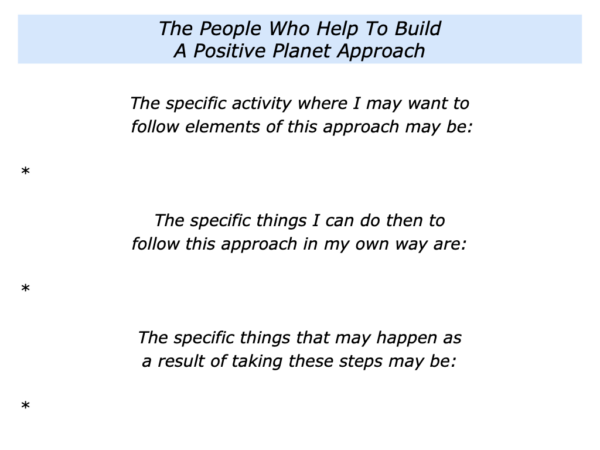






Leave a Reply